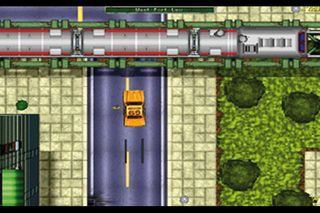Click here to read part one of our three part 'The making of Grand Theft Auto' feature
Click here to read part two of our three part 'The making of Grand Theft Auto' feature
Friday 7 July 2006
While the original vision of Grand Theft Auto was scaled back for PC, the PlayStation version, although preserving the core of the game, lost even more features, including fire engines and trains. But 18 months into development, the entire city had to be razed and rebuilt, as one programmer Brian Baird recalls.
"[Programmer] Mike Dailly came up with a new technique to draw 24bit colour tiles instead of the low-res ones we were using. Technically, it was stunning for its time but it required every single tile and graphic in the game to be redrawn. We borrowed most of the artists in the company to blitz the tiles for an ECTS demo to show off this new style."
If a new feature promised a better game, then it was included seemingly irrespective of the extra cost. The new artwork added another 12 months to the schedule. As Baird puts it: "There was always an overall plan with GTA. However, the day-to-day development was more flying by the seat of our pants."

Above: It makes perfect sense that music from the 'car stereo' becomes muffled as your car passes under a bridge
Fortunately, publisher BMG was generally sympathetic, with a very hands-on approach from producer Gary Penn. Relations with BMG in the US, however, were not always as smooth. As BMG took on more people from within the industry, some began to voice concerns, as publisher DMA's studio boss Dave Jones recalls: "We could not compete graphically with, say, Ridge Racer, so we were banking on the fact that the game was radical in terms of gameplay and its edgy content.
"The content side was never an issue. BMG supported us 100% to put whatever we wanted into the game; coming from the music business nothing fazed them. It was a real shame to see BMG lose its fresh approach and become more like a games publisher. BMG US didn't think you could release a top-down game into the market.
"They said it would simply not sell and we should drop the title. This was only three months from completion. I was confident the sheer fun and originality factors would make it a success, and we also had great backing from BMG Europe. Luckily, we won the argument."
Above: It makes perfect sense that music from the 'car stereo' becomes muffled as your car passes under a bridge
Fortunately, publisher BMG was generally sympathetic, with a very hands-on approach from producer Gary Penn. Relations with BMG in the US, however, were not always as smooth. As BMG took on more people from within the industry, some began to voice concerns, as publisher DMA's studio boss Dave Jones recalls: "We could not compete graphically with, say, Ridge Racer, so we were banking on the fact that the game was radical in terms of gameplay and its edgy content.
"The content side was never an issue. BMG supported us 100% to put whatever we wanted into the game; coming from the music business nothing fazed them. It was a real shame to see BMG lose its fresh approach and become more like a games publisher. BMG US didn't think you could release a top-down game into the market.
"They said it would simply not sell and we should drop the title. This was only three months from completion. I was confident the sheer fun and originality factors would make it a success, and we also had great backing from BMG Europe. Luckily, we won the argument."
